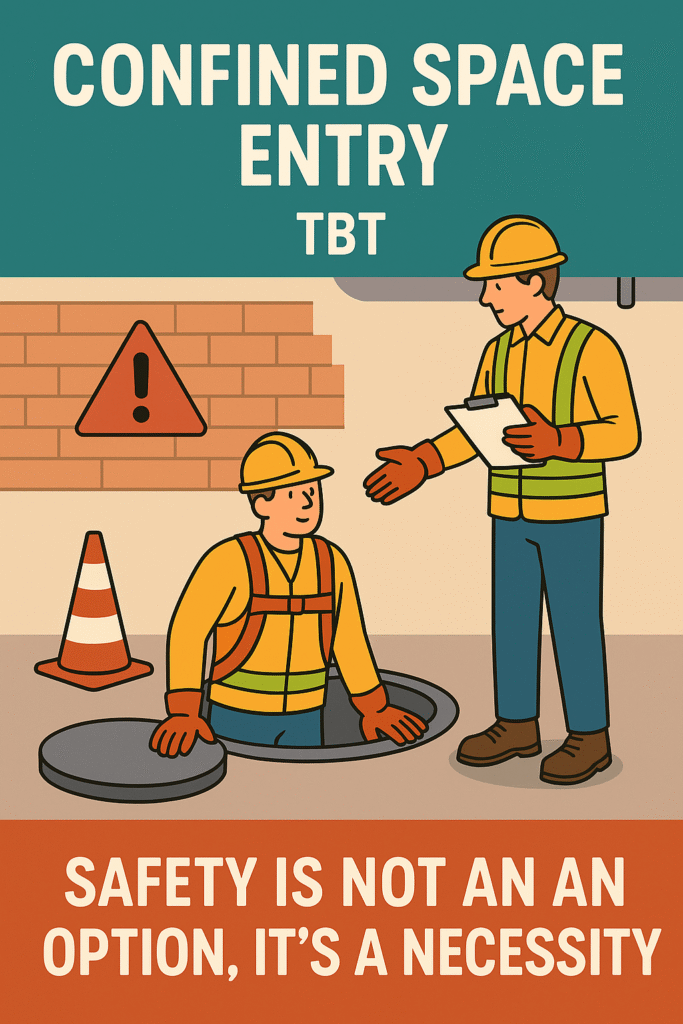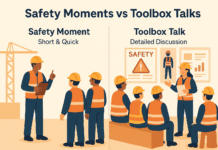
Confined Space Entry TBT
Good morning team,
Today’s safety talk is about Confined Space Entry — one of the most dangerous types of work you can do on a construction or industrial site.
When we talk about “confined spaces,” we mean any enclosed or partially enclosed area that is large enough for a person to enter but has limited entry and exit points — and is not designed for continuous occupancy.
Examples include:
- Tanks and silos.
- Manholes.
- Utility vaults.
- Boilers.
- Pipelines.
- Pits and sumps.
These spaces can be deadly because hazards in confined spaces are often hidden — you can’t always see or smell them until it’s too late.
1. Why Confined Space Safety Matters
- Confined space accidents often result in multiple fatalities — rescuers sometimes become victims themselves.
- Hazards can develop suddenly — oxygen depletion, toxic gas leaks, or flooding.
- Even experienced workers can be caught off guard if proper procedures aren’t followed.
- Statistics show most confined space deaths happen because work started without testing or proper controls.
2. Hazards in Confined Spaces
2.1 Hazardous Atmospheres
- Oxygen Deficiency – Below 19.5% oxygen can cause dizziness, unconsciousness, and death.
- Oxygen Enrichment – Above 23.5% oxygen increases fire and explosion risk.
- Toxic Gases – Hydrogen sulfide, carbon monoxide, ammonia.
- Flammable Vapors – From fuels, solvents, or chemical residues.
2.2 Engulfment
- Loose materials like sand, grain, or sludge can bury a person.
2.3 Physical Hazards
- Moving machinery parts.
- Extreme temperatures.
- Noise and vibration.
- Slips, trips, and falls.
2.4 Restricted Movement
- Tight spaces make it harder to escape quickly during an emergency.
3. Control Measures – Safe Entry Process
3.1 Permit to Work
- No one enters a confined space without a valid Confined Space Entry Permit.
- The permit ensures hazards are identified and controls are in place.
3.2 Atmospheric Testing
- Test for oxygen, flammable gases, and toxic vapors before entry.
- Continue monitoring while work is in progress.
3.3 Ventilation
- Use mechanical ventilation to maintain safe air quality.
- Never rely on natural airflow alone.
3.4 Isolation
- Lockout/tagout machinery.
- Disconnect and secure lines that could introduce gases, liquids, or solids.
3.5 Communication
- Maintain constant contact between entrants and the attendant outside.
3.6 Rescue Plan
- Have trained rescue personnel ready before work starts.
- Never attempt unplanned rescue — it often results in multiple fatalities.
4. Roles and Responsibilities
4.1 Entrant
- Follow permit requirements.
- Wear required PPE.
- Maintain communication.
4.2 Attendant
- Stay outside and monitor entrants.
- Keep track of who is inside.
- Call for rescue if needed.
4.3 Entry Supervisor
- Authorize and oversee entry.
- Ensure hazards are controlled.
- Cancel permit when work is done.
5. PPE for Confined Space Entry
- Hard hat.
- Protective clothing (flame-resistant if needed).
- Gloves suitable for the work.
- Safety boots.
- Respiratory protection (SCBA or supplied-air respirator if required).
- Fall protection harness with retrieval line.
6. Do’s and Don’ts
✅ Do:
- Use a valid permit.
- Test the air continuously.
- Keep entry and exit points clear.
- Follow lockout/tagout procedures.
- Maintain communication at all times.
❌ Don’t:
- Enter without authorization.
- Rely on your senses to detect gases.
- Remove ventilation during work.
- Attempt a rescue without proper training.
7. Step-by-Step Safe Entry Procedure
- Conduct a job hazard analysis.
- Obtain and complete the entry permit.
- Test the atmosphere with a calibrated gas monitor.
- Ventilate as necessary.
- Isolate the space from hazards.
- Set up communication systems.
- Have rescue equipment and personnel ready.
- Begin work following safe practices.
- Monitor atmosphere continuously.
- Exit immediately if conditions change.
- Close permit once work is complete and area is safe.
8. Real-Life Case Study
A maintenance worker entered a sewer manhole to retrieve a tool. The air was oxygen-deficient due to decomposing waste. He collapsed within seconds. A co-worker entered to help and collapsed too. Both died before rescuers arrived.
Lessons:
- Never enter without testing the atmosphere.
- Always have a trained attendant and rescue plan.
- Don’t rush in to save someone without proper equipment — you could become the next victim.
9. Worker Engagement – Q&A
- What are the three main types of hazardous atmospheres?
- Who is allowed to authorize entry?
- Why is continuous monitoring necessary?
10. Closing Words – Bringing It Back to the Start
Alright team, we began this morning talking about how confined spaces can be silent killers. The danger isn’t always obvious — you can’t smell oxygen deficiency, and you can’t see flammable gases.
That’s why we plan every entry, test every space, ventilate every job, and communicate every step.
If something feels unsafe — stop immediately. No job is worth your life.
Remember: Most confined space fatalities happen because someone thought, “It’ll only take a minute.” That’s not good enough here.
Let’s make sure every confined space job is done the safe way — the only way.
Stay alert, stay safe, and let’s have a productive day.
Reporting Near Misses 5 Minute Safety Talk
Heat Stress and Hydration 5 Minute Safety Talk
Confined Space Entry 5 Minute Safety Talk
























